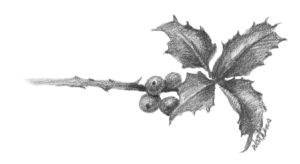December, Winter Greenery
By Leslie Watkins
This year the astronomical first day of winter in the Northern Hemisphere falls on Friday, December 21. We will experience about nine hours and 15 minutes of sunlight on this shortest day of the year, the Winter Solstice. The word solstice comes from the Latin for “sol”, meaning sun and sistere, ‘to make stand”. It heralds the return of the sun and the hope for new life. It has been celebrated around the world for ages. Megalithic structures like Stonehenge (about 5,000 years old) line up perfectly with sun rays during the winter solstice sunset. Knowing when the solstice occurs helps growers to calculate when to begin planting.

Holly, Leslie Watkins © 2018
At Yuletide, Scandinavian and German people burn Yule logs on the family hearth to welcome back the light. A piece of the log is kept in the house as a token of prosperity and used to light the yule log the following year. Yuletide is celebrated between December and January and lasts about twelve days. The Chinese celebrate Dong Zhi, meaning “Winter Arrives”, to welcome longer days and positive energy. It’s an occasion for families to celebrate the past year and share good wishes for the year to come. Japanese farmers traditionally practice “Toji”, to start the new year with health and good luck. It is a sacred time, welcoming back the sun that will nurture the crops in the coming year. In North America, for the Zuni and the Hopi peoples, the winter solstice signifies the beginning of the new year. At the setting of the solstice sun, an all night ritual begins with ceremonial fire-lighting, dancing and gift-giving. The Sun-watcher’s observations govern the planting of crops and timing of other rituals throughout the year.
Christmas as we know it is predated by the ancient Egyptians in worship of Ra or Horus, the sun-god child of Isis and Osiris. In Mesopotamia, Marduk was believed to fight against cold and darkness and was also worshipped on the solstice. Romans celebrated Saturnalia, later renamed “Sol Invicti’ which means “the unconquerable sun”, in honor of Apollo. The Persians celebrated the birth of Mithra, the god of light or sun-god, who was born out of a rock. The Greeks who conquered the Persian Empire under Alexander of Macedon in the 4th century BCE transferred Mitheraism from Iran (ancient Persia) to Europe. Mitheraism was widespread throughout Europe and was still practiced in 313 AD when the Roman Emperor Constantine the Great transitioned to Christianity.
The tradition of decorating our homes with evergreens, and in particular holly, originates in the north with the Druids who considered holly a sacred and protective plant. The rich green leaves and bright red berries persist through the harshest weather, symbolizing fertility and eternity amid the darkest days of winter. It was believed to protect homes against lightning strikes and holly was the wood used to make Harry Potter’s famous wand.
Queen Victoria popularized the old Germanic tradition of bringing trees and evergreens indoors during Yuletide. An engraving of the royal family entitled “Christmas Tree at Windsor Castle” appeared in the London Illustrated News in 1848. That, along with Charles Dickens’ “A Christmas Carol”, published in 1843, helped shape Christmas traditions as we know them today. The first “official” tree at Rockefeller Center went up in 1933, but the first actual tree was erected by construction workers who cleared the site in 1931. The tree from 2016, a Norway Spruce from Oneonta, NY, was the second tallest ever erected at 94 feet high, and the widest at 56 feet. It weighed over 30,000 pounds. Since 2007 each Rockefeller Center tree has been milled into lumber and donated to Habitat for Humanity for home construction.
Many evergreens growing in our area are useful for holiday decorations. Holly, balsam, pine, cedar, and spruce all work well. Trim sprigs with sharp clippers at a 45º angle and place the cuttings in a bucket of water to hydrate. They should keep for about two weeks if kept cool, out of sunlight, and misted regularly. To make a wreath, simply bend a wire clothes hanger into a circular shape and using florist’s wire wrap bunches of the greenery to the frame. Decorate with ribbon, pinecones, and holly.
December Greenery
Arborvitae
Balsam Fir, tree, fragrance
Blue Spruce, better outdoors
Boxwood, indoors and out
English Ivy, all decorations
Fraser Fir, tree, garlands
Holly, berries, all decorations
Juniper, good indoors and out
Mountain Laurel
White Pine, boughs and cones
